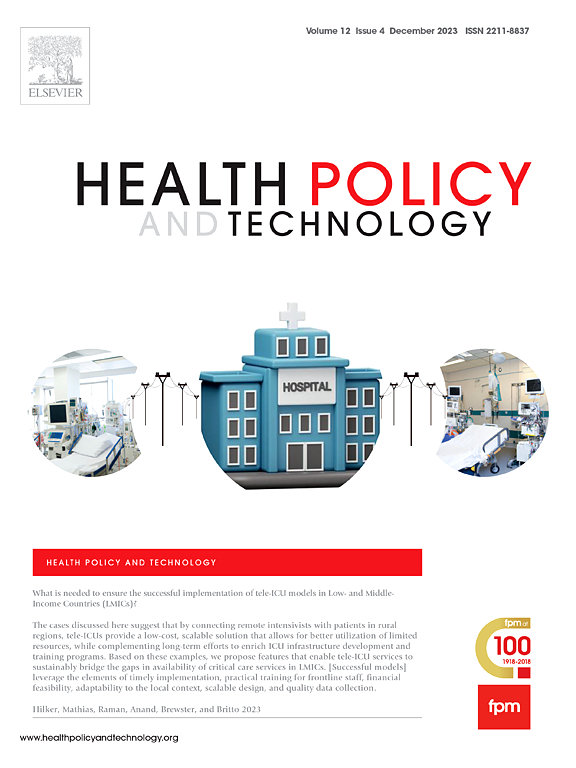The challenge of telemedicine – using SWOT methodology and value-based assessment to analyze barriers, incentives and opportunities: Opening the digital doors to expand access and health equity
IF 3.7
3区 医学
Q1 HEALTH POLICY & SERVICES
引用次数: 0
Abstract
Objective
Telemedicine can enhance efficiency and accessibility to high-quality care. Moreover, it can improve satisfaction by increasing the responsiveness of medical professionals, expert consultation and multidisciplinary meetings, especially in an era of a pandemic. During 2020, ambulatory care was dramatically reduced, and while telemedicine emerged as the only method of delivering care, we witnessed variability among physicians in the implementation of telemedicine. In order to identify leading themes to assess the successful implementation of telemedicine, we used SWOT (strengths, weaknesses, opportunities and threats) methodology that enables management of positions on the assimilation of technology.
Materials and Methods
A structured questionnaire was distributed in a controlled manner to all the teams that were involved in hospital ambulatory clinics (HAC).
Results
Out of 306 workers directly involved in HAC telemedicine, 146 replied (48 % response rate). The professional distribution of the responders was: 75 physicians (56 % specialists, 40 % medical directors), 51 nurses (51 % of them in managerial positions) and 20 administrators. Using SWOT analysis, we identified that the most positive influential factor to telemedicine implementation was improving accessibility, and the main barrier was the lack of sufficient physical examination. Nurses and administrators scored higher on telemedicine opportunities (P = 0.048), threats (P < 0.001) and technological added value (P = 0.001). The multivariable model showed that when the participant was more experienced, telemedicine was less perceived as a weakness and considered less threatening.
Conclusions
We found significant differences in perceptions toward telemedicine regarding threats and opportunities. Improving access to care, bridging the digital technology gap and preventing infections were all scored as the most important factors to accelerate implementation. SWOT analysis offers a wise methodology to assess the impact of change while many factors and stakeholders are involved. Additional analysis by value-based assessment elements (VBAE) revealed that >40 % of the users declared that improving "professionalism" was a major principle that added value and incentive to favor telemedicine.
远程医疗的挑战-使用SWOT方法和基于价值的评估来分析障碍、激励和机会:打开数字大门,扩大获取和卫生公平
目的远程医疗可以提高医疗服务的效率和可及性。此外,它还可以提高医疗专业人员、专家协商和多学科会议的反应能力,从而提高满意度,特别是在大流行时期。在2020年期间,门诊护理大幅减少,虽然远程医疗成为提供护理的唯一方法,但我们看到医生在实施远程医疗方面存在差异。为了确定主要主题以评估远程医疗的成功实施,我们使用SWOT(优势,劣势,机会和威胁)方法,使管理技术同化的立场成为可能。材料与方法将一份结构化问卷以受控方式分发给所有医院门诊(HAC)小组。结果在直接参与HAC远程医疗的306名员工中,有146人回复,回复率为48%。应答者的职业分布为:医生75人(专科医生占56%,医疗主任占40%),护士51人(管理岗位占51%),行政人员20人。通过SWOT分析,我们发现远程医疗实施的最积极影响因素是可及性的提高,主要障碍是缺乏充分的体检。护士和管理人员在远程医疗机会(P = 0.048)和威胁(P <;0.001)和技术增加值(P = 0.001)。多变量模型显示,当参与者更有经验时,远程医疗较少被视为弱点,并且被认为威胁较小。结论:我们发现人们对远程医疗的威胁和机会的看法存在显著差异。改善获得保健的机会、弥合数字技术差距和预防感染都被认为是加快实施的最重要因素。SWOT分析提供了一种明智的方法来评估变化的影响,同时涉及许多因素和利益相关者。基于价值的评估要素(VBAE)的进一步分析显示,40%的用户声称,提高“专业性”是增加价值和鼓励远程医疗的主要原则。
本文章由计算机程序翻译,如有差异,请以英文原文为准。
求助全文
约1分钟内获得全文
求助全文
来源期刊

Health Policy and Technology
Medicine-Health Policy
CiteScore
9.20
自引率
3.30%
发文量
78
审稿时长
88 days
期刊介绍:
Health Policy and Technology (HPT), is the official journal of the Fellowship of Postgraduate Medicine (FPM), a cross-disciplinary journal, which focuses on past, present and future health policy and the role of technology in clinical and non-clinical national and international health environments.
HPT provides a further excellent way for the FPM to continue to make important national and international contributions to development of policy and practice within medicine and related disciplines. The aim of HPT is to publish relevant, timely and accessible articles and commentaries to support policy-makers, health professionals, health technology providers, patient groups and academia interested in health policy and technology.
Topics covered by HPT will include:
- Health technology, including drug discovery, diagnostics, medicines, devices, therapeutic delivery and eHealth systems
- Cross-national comparisons on health policy using evidence-based approaches
- National studies on health policy to determine the outcomes of technology-driven initiatives
- Cross-border eHealth including health tourism
- The digital divide in mobility, access and affordability of healthcare
- Health technology assessment (HTA) methods and tools for evaluating the effectiveness of clinical and non-clinical health technologies
- Health and eHealth indicators and benchmarks (measure/metrics) for understanding the adoption and diffusion of health technologies
- Health and eHealth models and frameworks to support policy-makers and other stakeholders in decision-making
- Stakeholder engagement with health technologies (clinical and patient/citizen buy-in)
- Regulation and health economics
 求助内容:
求助内容: 应助结果提醒方式:
应助结果提醒方式:


